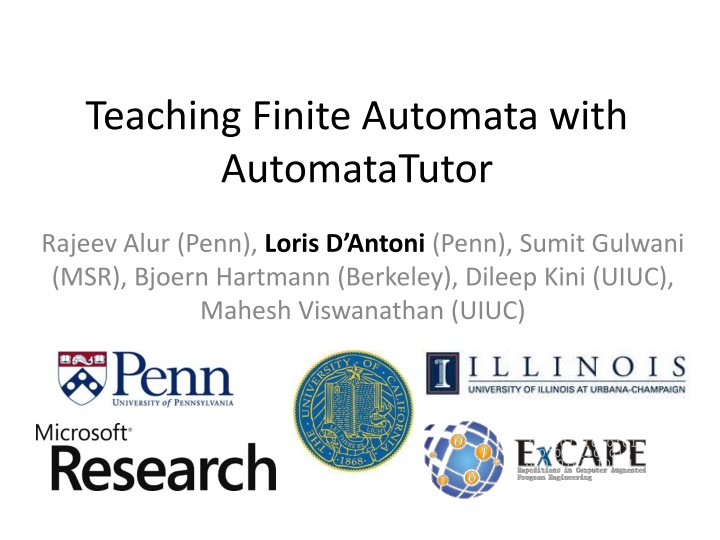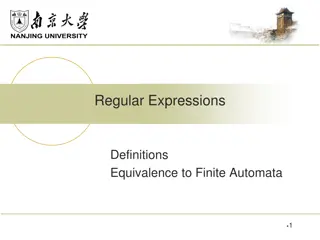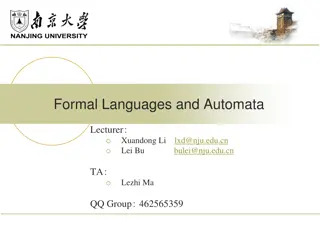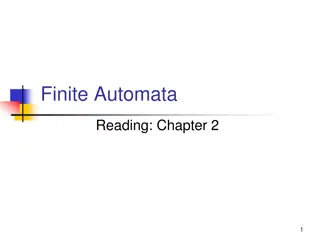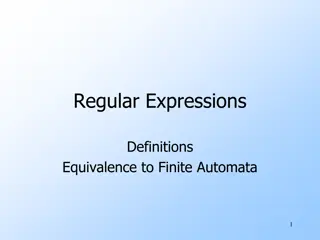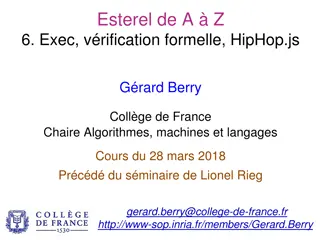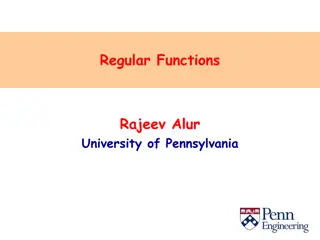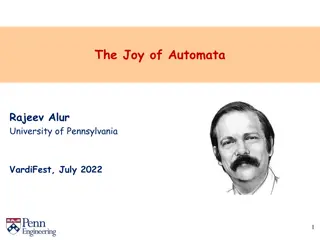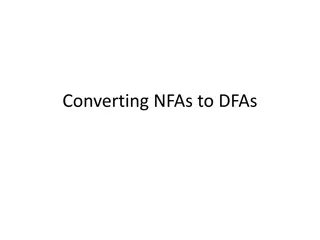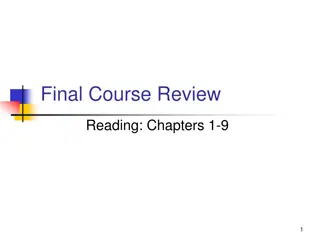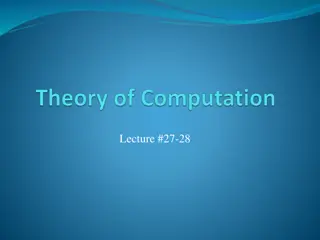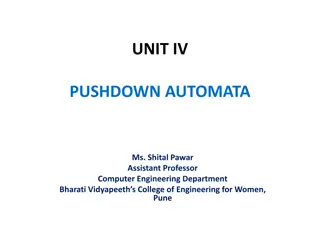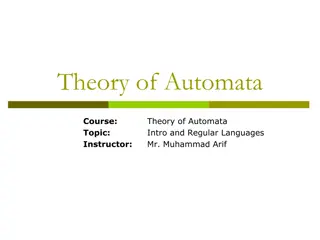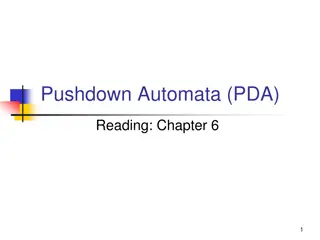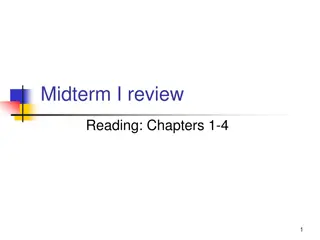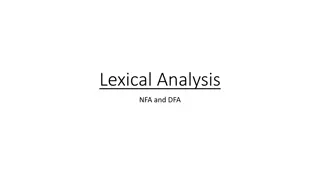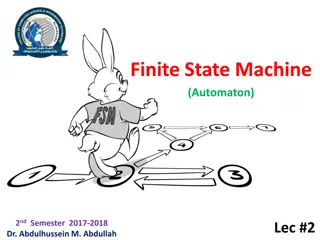Teaching Finite Automata with AutomataTutor
Explore the key concepts of finite automata with insights from leading experts in the field. Understand the importance of automata in computer science education, common challenges faced by students, and practical examples on drawing DFAs for specific languages. Discover different types of mistakes encountered in automata problems and solutions.
Download Presentation

Please find below an Image/Link to download the presentation.
The content on the website is provided AS IS for your information and personal use only. It may not be sold, licensed, or shared on other websites without obtaining consent from the author.If you encounter any issues during the download, it is possible that the publisher has removed the file from their server.
You are allowed to download the files provided on this website for personal or commercial use, subject to the condition that they are used lawfully. All files are the property of their respective owners.
The content on the website is provided AS IS for your information and personal use only. It may not be sold, licensed, or shared on other websites without obtaining consent from the author.
E N D
Presentation Transcript
Teaching Finite Automata with AutomataTutor Rajeev Alur (Penn), Loris D Antoni (Penn), Sumit Gulwani (MSR), Bjoern Hartmann (Berkeley), Dileep Kini (UIUC), Mahesh Viswanathan (UIUC)
Why finite automata? Part of any CS curriculum Regexp and other models build on automata Students don t like Automata Hard and tedious to grade
Draw the DFA accepting the language: { s | ab appears in s exactly 2 times } Teaching Assistant + =
Teaching Assistant + = Teaching Assistant + + =
Draw the DFA accepting the language: { s | ab appears in s exactly 2 times } Solution:
Your DFA accepts the language { s | ab appears in s at least 2 times } Grade: 6/10
You need to change the acceptance condition of one state Grade: 9/10
3 types of mistakes: 1. Problem syntactic mistake You solved a slightly different problem 2. Solution syntactic mistake There is a typo in your solution 3. Solution semantic mistake Your solution is wrong on few test cases
1. Problem Syntactic Mistake The problem description was { s | ab appears in s exactly 2 times } The student instead drew DFA for { s | ab appears in s at least 2 times } INTUITION: find the distance between the two language descriptions
Feedback via Synthesis SYNTHESIZE LOGIC DESCRIPTION indOf(ab)=2 indOf(ab) 2 FIND MINIMAL EDIT Replace with = CONVERT TO ENGLISH { s | ab appears in s at least 2 times }
indOf(ab)=2 Classical ?? algorithm from MSO to DFA
From DFA to Logic 1. Enumerate all the predicates 2. For each predicate build DFA 3. Check for equivalence with target DFA Search pruning and speeding: Avoid trivially equivalent predicates (A V B, B V A) Approximate equivalence using set of test strings
2. Solution Syntactic Mistake The student forgot one final state INTUITION: find the smallest number of syntactic modification to fix solutions
DFA Edit Difference Compute DFA edit distance: Number of edits necessary to transform the DFA into a correct one An edit is Make a state (non)final Add a new state Redirect a transition
DFA Edit Difference: How to compute it? We try every possible edit and check for equivalence Speed up equivalence by using test set of strings The problem of finding DFAED is in NP (is it NP-hard?)
3. Solution Semantic Mistake The student didn t see that the a loop might not be traversed INTUITION: find on how many strings the student is wrong
Approximate Density S = correct solution Compute Symmetric Difference: D = S\A U A\S Measure relative size of D with respect to S Size(D,S) = limn-> Dn/Sn Size(D,S) is not computable in general (the limit oscillates) Approximate the limit to finite n A = student attempt
Are the computed grades fair? YES [IJCAI13] Is the computed feedback helpful? YES (in some sense) [submitted to TOCHI14] Is anyone else (beside me) going to use the tool? It seems like a YES (Penn, UIUC, Reykjavik)
Grades Evaluation 1/2 H1, H2 = human graders N =na ve grader T = tool 100? Percentage? of? a empts? within? X? 90? 80? 70? H1-N? H1-H2? H1-T? 60? Tool is closer to humans than humans are to each other 50? 40? 30? 20? 0? 1? 2? 3? 4? 5? 6? 7? 8? 9? 10? Grade? Difference?
Grades Evaluation 2/2 H1, H2 = human graders N =na ve grader T = tool Tool and humans look indistinguishable
Pros and Cons Pros: On disagreeing cases, human grader often realized that his grade was inaccurate Identical solutions receive same grades and correct attempts awarded max score (unlike human) Cons: For now limited to small DFAs When two types of mistakes happen at same time, the tool can t figure it out
How to test whether students are engaged? Setup: 4 mandatory homework problems 18 practice problems Question: How often does a student give up on a practice problem based on his type of feedback? Results: Binary Feedback: 44 % of the time Counterexample: 27 % of the time Hint Feedback: 33 % of the time
Is anyone else (besides me) going to use the tool?
Univ. of Reykjavik test We used the previous experiment s results to improve the tool and we removed sources of confusion.
4.40 4.31 4.34 2.09
Univ. of Reykjavik test I thought the feedback was absolutely Excellent. It helped me solve a couple of exercises, helped me with the extreme/end cases. It was short, simple and to the point! I liked its subtle hints. This is a far superior way to learn new things rather than read about something I hope this way of teaching will be implemented in all schools Sometimes the feedback was confusing
A tutoring system? A student (Alexander Weinert) worked on it at Berkeley as part of Sanjit Seshia s class NFA constructions? A student (Matt Weaver) is working on it over the summer at Penn Regular expressions?
Conclusions AutomataTutor.com: a tool that grades DFA constructions fully automatically and provides students with personalized feedback We will fully deploy it by Fall14.
